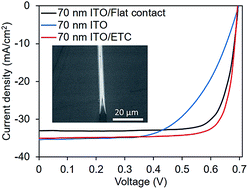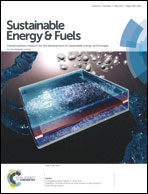Silicon heterojunction solar cells with effectively transparent front contacts
Abstract
We demonstrate silicon heterojunction solar cells with microscale effectively transparent front contacts (ETCs) that redirect incoming light to the active area of the solar cell. Replacing standard contact electrodes by ETCs leads to an enhancement in short circuit current density of 2.2 mA cm−2 through mitigation of 6% shading losses and improved antireflection layers. ETCs enable low loss lateral carrier transport, with cells achieving an 80.7% fill factor. Furthermore, dense spacing of the contact lines allows for a reduced indium tin oxide thickness and use of non-conductive, optically optimized antireflection coatings such as silicon nitride. We investigated the performance of ETCs under varying light incidence angles, and for angles parallel to the ETC lines find that there is no difference in photocurrent density with respect to bare indium tin oxide layers. For angles perpendicular to the ETC lines, we find that the external quantum efficiency (EQE) always outperforms cells with flat contact grids.



 Please wait while we load your content...
Please wait while we load your content...